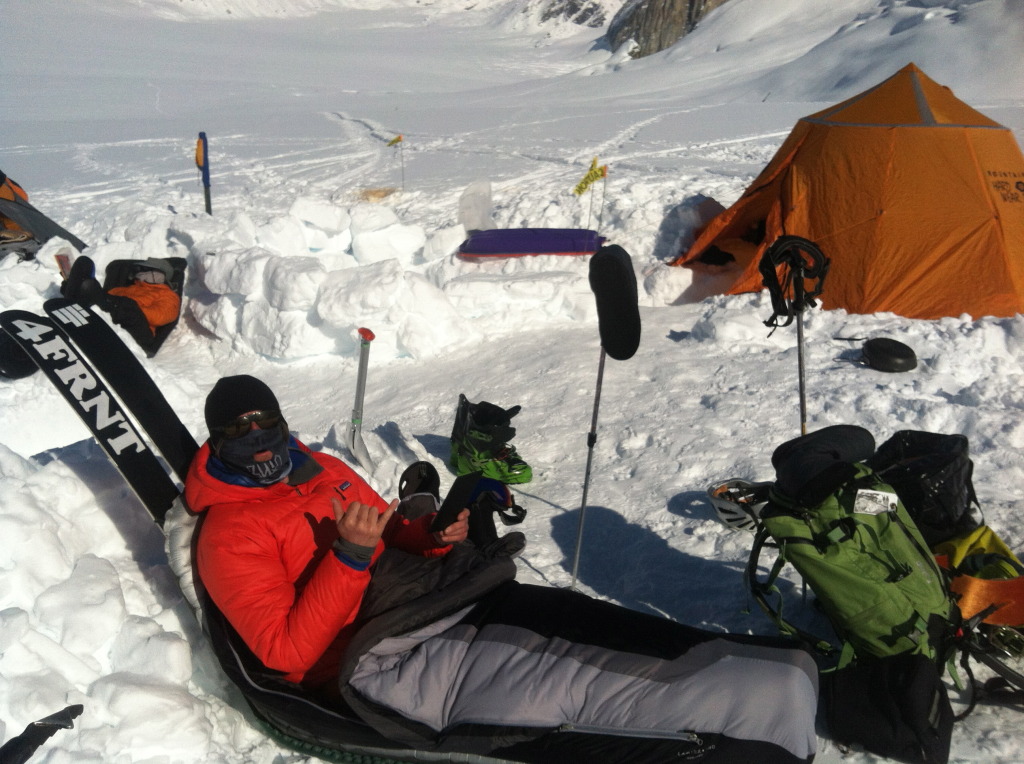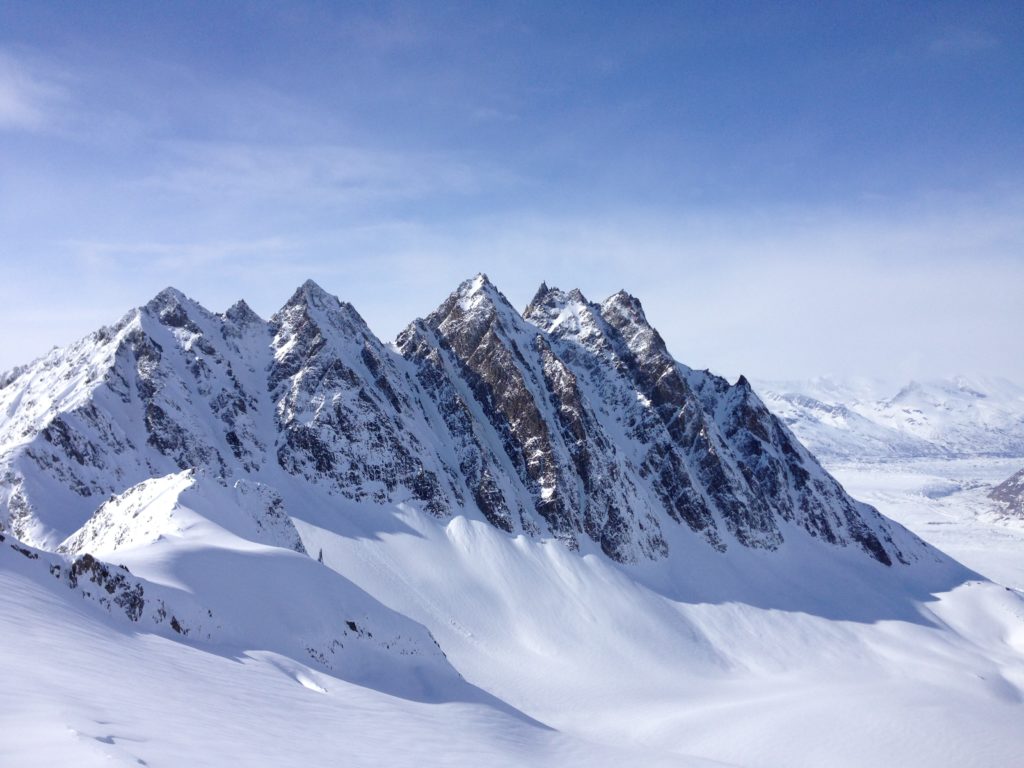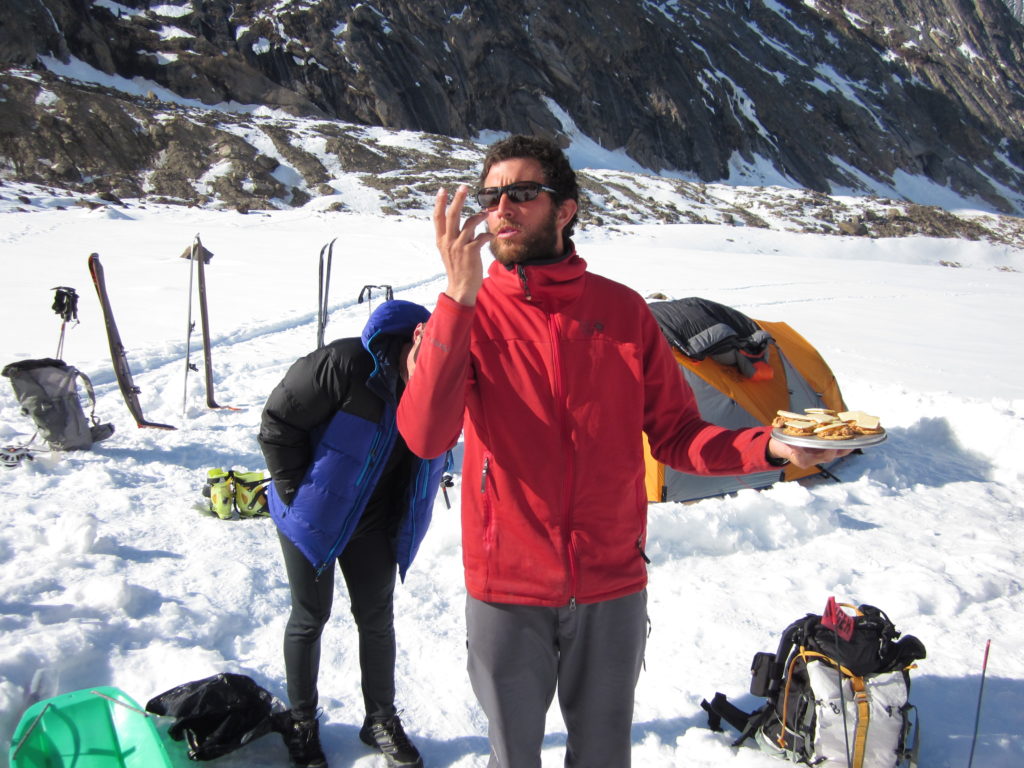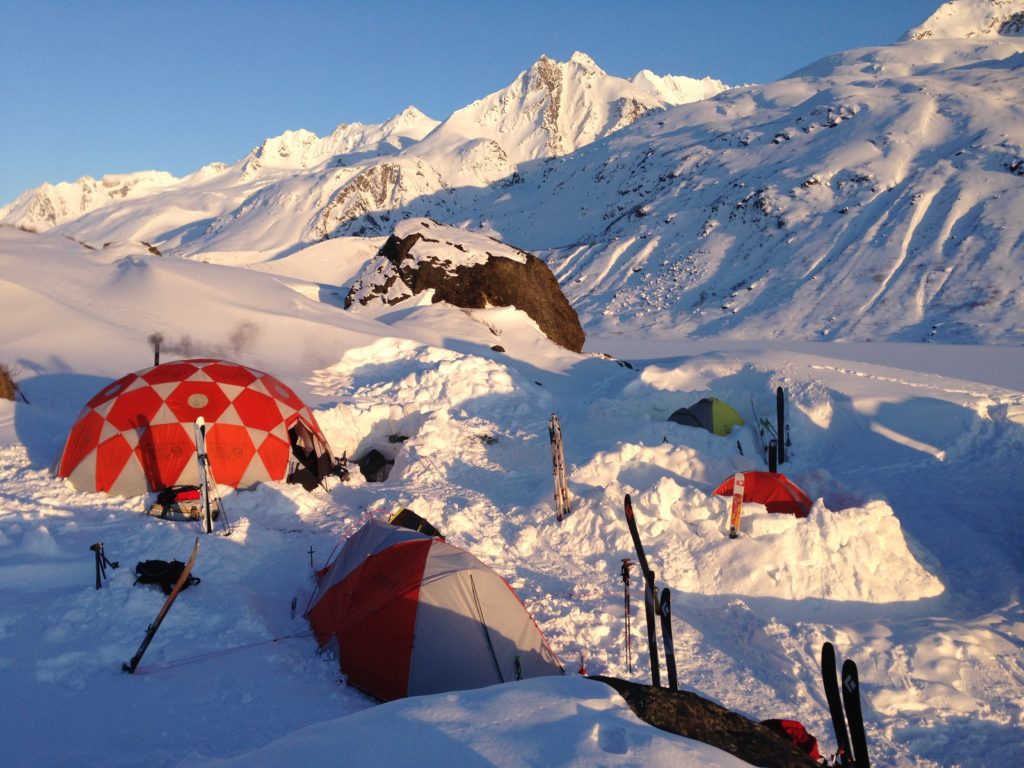I’m not a writer, but I enjoy the challenge it presents and the introspection it can award. And I really like sharing and discussing adventures on snow. I was invited to contribute to the new backcountry ski journal Ascent. The first issue was just released in print and most of the content is also available online. Ascent will be different in a few ways that appeal to me, it’s written by actually backcountry skiers and it’s FREE! Here is an article submission on ski camping in the latest issue.
It’s dark and cold and as you glide back into camp and all you want to do is crawl into your sleeping bag and die to the world, but you can’t. You’re body needs fluids and food to keep your internal stove burning warmly through the night. Today’s approach turned out to be longer than it initially looked, so was the couloir, and then the slog “home” seemed eternal. Despite several layers of sunscreen, your face is burned by sun and wind and your lips are dry.
The first and most important move is to put on all your puffy down layers. The warm moisture inside your clothing will soon become your enemy. After the insulation you need to add fuel to the inner fire, time to get dinner started. A stove is your salvation and once it’s cranking you can melt snow and then boil water for a dinner that would never pass as food at home. Next the wet boots come off and warm dry socks and down booties replace them. A friend makes a comment about how good today was, or maybe tells a joke, or maybe it’s just silent since talking about another “best run of your life” is only diminished by words. These simple yet critical routines have become the rituals for comfort and survival over the past week of ski camping in the snow.
This might sound like hell to some and at times it can be, but this was a good day. This is what you came here for. Nobody fell in a crevasse, burned themself on the stove, was caught in an avalanche, or tomahawked down a chute. For the ultimate in freedom there is a price to pay. If climbing and skiing peaks in perfect snow that few- or none- have seen before, is what you’re into then there is no better way than catapulting yourself into remote wilderness and base camping there.
“At bottom, mountains, like all wildernesses, challenge our complacent conviction – so easy to lapse into – that the world has been made for humans by humans. Most of us exist for most of the time in worlds, which are humanly arranged, themed and controlled. One forgets that there are environments which do not respond to the flick of a switch or the twist of a dial, and which have their own rhythms and orders of existence. Mountains correct this amnesia. By speaking of greater forces than we can possibly invoke, and by confronting us with greater spans of time than we can possibly envisage, mountains refute our excessive trust in the man-made. They pose profound questions about our durability and the importance of our schemes.” Robert Macfarlane, Mountains of the Mind
It was local’s night at O’Shucks in Park City, UT when my heart jumped as I realized I was sitting next to the Jeremy Nobis. I was young, impressionable and a little drunk and here was a ski hero of mine. We started talking about skiing, big surprise. He lit up and started in on Alaska. “Do whatever it takes to get up there, max out the credit card or whatever it takes, but you’ve got to go to Alaska.” He spoke with the intensity and conviction used by men that have created cults and religions. He made a believer out of me. It took another year or two to follow his command, but I did. Nine years and 13 expeditions later I’ve been back almost every year since. Without a budget for heli-skiing the option is to tour, but the mountains of Alaska are huge and it quickly became clear that camping was the best way.
You’re standing alone, just you and a pile of gear as the snow from the plane sandblasts you; this is both intimidating and exhilarating. The learning curve is sharp. Spend two weeks in the snow and you’ll quickly dial in what works and what doesn’t. It’s really a matter of your sleeping system and cooking kit, the rest is a luxury. I’m continually taking notes and tweaking systems to make them lighter, more packable and trying to get more than one use out of every item possible.
Nowhere else in the world has the terrain, snow quality, access and affordability that Alaska owns. Where else can you scour Google, pick a spot on a map and have a pilot land you there for around $600?! Maybe Canada, if you don’t mind travel in a third world country. Alaska is still the Wild West. You can fly into Anchorage, find a pilot to drop you off in the middle of nowhere and he doesn’t even take down your name or contact information. (Though this is not recommended!)
Everybody is a pilot in Alaska, but experienced folks with plenty of glacial and snow-landing experience is the preferred form of travel. Drake Olsen will get you to the goods in Haines. Silvertip Aviation and Mike Meekin are based out of Wasilla/Palmer and will skillfully drop you into the Chugach, Tordrillo and Talkeetnas. Paul Claus at Ultima Thule is the gatekeeper for the Wrangells, and Talkeetna Air Taxi is the way for the Central Alaska Range. Avoid Joe Schuster and Sportsman Air unless you’d like to run out of gas mid-flight, have him change his mind on the price of your trip at the last minute, or get barked at as he kicks you out of his plane in the Revelations. Whoever it is, get a price quote via email before you head up so you can reference it with them if need be. Find out what weight limits there are and pack accordingly. You may be able to save yourself some money by scaling down a little. Rent a good satellite phone to keep in touch with your pilot once on the glacier. There are several services in Anchorage to choose from. Keep in good contact for current weather and conditions, or just look out the tent. Remain flexible with travel dates since getting snowed in, or out, is highly likely. Two weeks seems to be the magic number. In this time you’re likely to get some weather, some sun and some good skiing.
Whether it’s Haines, the Chugach, Revelations, The Wrangells, Tordrillos or any of the lesser-traveled ranges it’s hard to go wrong. Each area has it’s own characteristic weather, snowpack and terrain. Even a “bad year” in Alaska can be the best you’ve ever had. Pick a spot with plenty of objectives and many aspects and this will give you more options to choose from when conditions vary. Skiing large objectives like Denali or Mount Logan are classic expeditions, but your chance of good snow is very slim. In fact, you spend most of your trip hauling shit around from camp to camp and then skiing with obscenely large packs. Good fun of a different sort. Ski camping in one area at lower elevations gives you great odds of getting good lines in good snow. The beauty of Alaska is that even “small” lines can easily be three to five thousand feet long.
It can be intimidating to jump into, but start small and work your way up. Once your backcountry travel skills are honed, head out into your local range for a night or two. Rainier is a great spot to get glacier camping experience and gear dialed. Take notes on what you used and didn’t, then drop the unnecessary. Letting go of all the peripheral shit in your life and living simply is one of the requirements built into mountain travel. Seeing what you dare get away without is a fun game and mental practice. By creating a good team gear checklist, you can eliminate redundant items and lighten your load. Prepare and plan and then most importantly be ready for adaptation and flexibility. You will forget something, or break gear; it’s part of the game. Use creativity and ingenuity to get by. Nick Devore and Will Cardamone forgot tent poles on a 17-day trip near Haines. They argued and blamed each other for a few minutes and then shut up and dug out a snow cave. They slept better than the rest of us during that trip which included an 8-day snowstorm.
Pick your partners wisely. Who will work and play hard? Who can suffer well and laugh often? You’re time together will be plentiful and intense as you get lost, reach summits, burn meals, snore loudly, spill pee bottles and break trail beyond your comfort zone.
Camp is crucial. This is your home and your last line of defense from the elements. Choose your campsite wisely. Finding a spot that sees sunlight and not much wind will make things more pleasant. Probe around for crevasses and avoid avalanche run-outs. Pick tents that can hold up to heavy snowfall and strong winds. Always build snow walls to surround and protect your village, even if it’s calm when you arrive. An open floor cook tent like a Megamid or Hoopster is a nice luxury. By digging out benches and a kitchen counter you can create a comfortable hang out for cooking, dining and boiling water, which will take up a large amount of your time. A large dome tent can be a great shelter. These are almost indestructible and can take the place of using multiple tents. You can dig the floor out in multiple configurations for sitting, sleeping and cooking. They have plenty of headroom and space to hang and dry out gear. The downside is they are heavy, take a while to set up and you won’t want to move them frequently.
Dine well and dine often. Food is for comfort and necessity. Bring lots of items that crossover and could be used during breakfast, lunch and dinner. This way you can mix it up and add diversity. The Costco in Anchorage is a great place to load up on frozen pastas, coffee, bacon, cheese and other bulk items. I base most meals off the tortilla or bagel, which can both be used in an infinite array. A few items I never leave home without include Tapatio, Nutella, onions, garlic, Probars, Emergen-C, and ramen. Again, get creative, which you’ll have plenty of time to do on weather days. Last year we discovered whiskey Snicker pancakes because those were the three items we had left over. Delicious! Seriously, try these at home.
Down days are to be expected and through the years I would guess I’m batting .500 for ski days. Expeditions are usually fully on, or fully off. You’re either skiing through long days, or reading through longer days and nights. Plenty of books on tape or on paper will help maintain sanity. If and when that fails, booze and board games can save the day.
A few key items:
-Thin plywood 2’X4’= makes a nice cutting board and counter top, keeps stoves from melting into the snow
-Small solar panel and battery= place in the sun while you’re out during the day and you’ll have power to charge batteries overnight
-Wet wipes and sanitizer= help make a cleaner potty experience and occasional backcountry bath
-Jet-Boil= for quick snowmelt and taking out on long days to stay hydrated
-Large mouth Gatorade bottle= to pee in at night so you don’t have to get up and go outside
-Insulated blow up mattress with chair kit= for a good nights sleep and comfortable seating in cook tent
-Down booties or overboots= keep feet warm and make you happy. Make sure to keep them dry.
-Cookie dough= a spoonful before bed keeps you warm all night
-Boiled water in a Nalgene bottle= add to sleeping bag for extra warmth, or put inside your socks to dry them out
-Buff= for warmth, sun protection, cleaning dishes, wiping your ass, bandage (not necessarily in this order)
-Small speaker= for chilling and impromptu dance parties
-Hydro Flask thermos= put hot water in it at night so it doesn’t freeze and you have starter water for coffee and breakfast in the morning
-Melatonin= natural sleep aid
You finally shed all your layers, roll your down coat into a pillow and slide into your sleeping bag with your boot liners so they will dry out overnight. You close your eyes, but you still see mountains, huge peaks and faces like the one you skied today and the ones you might ski tomorrow. Day touring, yurts and huts can all offer great snow, terrain, and different ways to experience the backcountry. However, nothing else offers the ultimate skiing potential that spending weeks living by your own means on a glacier can. Sure, you don’t belong out here and everything around you confirms this. But, despite your evolutionary inadequacies to handle cold weather, with the right gear, good planning, and some luck, you’re able to blur the line between surviving and thriving.









Great read! You and Jonah should write a book about your experiences and advice, filled with your goofball humor. Something between How to Shit in the Woods, Allen and Mike Backcountry and Epic Tails: Stories of Survival.
Ski More Powder!
Nice read. What I’m wondering about is the wood stove pipe coming out of that tent! Want want want!